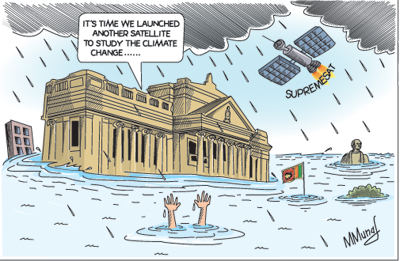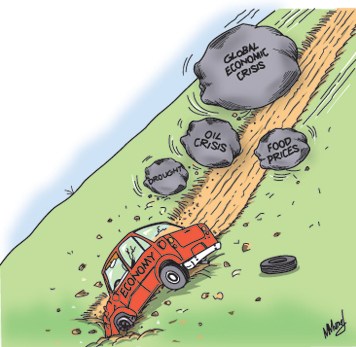Columns
Economy vulnerable to climate change
View(s):This year has seen some of the worst damages caused by climatic changes. Storms, floods droughts and extreme weather all around the world has wrought havoc to human lives and damaged crops in vastly different areas of the world.

These occurrences are attributed to global climate changes. Despite massive international conferences for the last 20 years-the last being RIO+20 this year– little has been accomplished by way of changing lifestyles and technology to reduce global warming. There have been some improvements in technology that reduce emissions and an increased popular awareness in greening the economy. Yet meaningful actions by governments have been minimal and global warming continues.
World food prices
Global food production has been adversely affected by global warming and climate change that have aggravated the world food supply. In 2007 and 2008, climatic changes resulted in parts of China, Australia, Canada and New Zealand experiencing droughts. Large areas of China, Myanmar, Bangladesh and Sri Lanka faced floods. Weather conditions reduced the wheat crop in Canada by 20 to 25 percent. Milk production in New Zealand fell drastically owing to drought and rice production in Australia fell significantly. This year, too, the North American wheat crop was affected by drought and current international wheat prices have risen. Prices of milk and dairy products have also increased.
The world food equation that had been in balance for some time after the Green Revolution of the 1960s changed imperceptibly at first and then sharply in the last few years owing to both supply and demand factors. The declining trend in food production was accentuated by climate changes and increased demand resulted in an unprecedented rise in food prices. In 2005 alone food prices rose by 75 per cent. While climatic and other supply factors diminished the supply of food, the demand for food has been increasing.
The two large emerging countries of Asia– China and India — are increasing their demand for food due to increases in their population and increases in per capita incomes. Although both these countries had reduced their rates of population growth, the annual increase in population is huge — above one million more mouths to feed each year. In China the increase in incomes led to a phenomenal increase in demand for meat and dairy products. There have also been increases in demand for food from oil exporting countries in the Middle East and from Russia and Eastern Europe. These increases in demand for food have been fundamental reasons for increases in food prices.
Important Implications for Sri Lanka
We would have to accept climate changes as inevitable and adjust and adapt to mitigate their adverse impacts on the economy and agriculture. The impacts of climate change on the Sri Lankan economy are twofold. First climate changes in tandem with increased demand for food globally are increasing international prices of food.

As a food importing country, the cost of food imports would rise sharply and increase import expenditure. Any increase in food import expenditure is a strain on the trade balance, as the country is already importing twice as much as it exports and having a massive trade deficit. Second, climatic changes in the country could affect food and other crop production adversely as witnessed this year when drought affected a large extent of paddy cultivation and the tea crop dipped about 13 percent in the first nine months of the year. This shortfall in rice production could lead to rice imports at high prices and affect the trade balance adversely.
Needed responses
Since international food prices are likely to continue to be high there is a need for a national response to cope with this reality. Food self-sufficiency is not an attainable goal for Sri Lanka as there are items of food that we cannot grow in the country such as wheat and dhal. It is also unrealistic to expect huge increases in production of items that we produce very little. We produce only 15 per cent of our requirements of sugar and 20 per cent of our current requirements of milk and the demand for these will increase with increasing incomes. There are limitations in land availability and other resource constrains and the high costs of production may make it economically better to import these commodities rather than produce them locally.
On the other hand, there are commodities where we could increase production to satisfy our needs. In the case of paddy production, we are near self-sufficiency in a good year and there is a possibility of increasing paddy production by increasing yields as the current average yield of around 4.4 metric tons per hectare is below the potential yields. An increase in rice production is needed to have an adequate stock to meet short-falls in production, increases in population by about 200,000 persons per year and to substitute rice for wheat. There should also be efforts to increase the production of other grains such as finger millet (kurakan), cowpea, Soya, and local varieties of lentils. In spite of all these strategies there would be a need to import several items of food.
The cost of all food imports is fully met by the export earnings from tea alone and earnings from industrial exports finance food imports several fold. Therefore the country’s food needs, even at these high prices, could be met by a diversified and robust export sector. However exports have been declining. Since the food needs of the country cannot be met by local production alone but supplemented by imports an increase in export earnings are vital: agricultural production alone cannot meet the food needs of the country.
Climate change in Sri Lanka
There has been climate in Sri Lanka. In the last century temperatures have increased by 0.3 degrees centigrade and in the more recent 30 years from 1961 to 1990, the temperature has risen by 0.16 degrees centigrade. The mean temperature in the country is expected to rise by 1.2 to 1.6 degrees centigrade by 2050.The rainfall pattern too appears to have changed with more rain in the wet zone and less rain in the dry zone. The expectation is that there would be more rainfall in the dry zone from the South East monsoon and that the dry zone would get less rainfall from the North East monsoon. The rainfall and climatic changes are difficult to predict and this unpredictability of climate changes makes the adaption to them more difficult and challenging.
The recent destruction of crops by floods after a severe drought exemplifies these changes. Our main crops of paddy, coconut and tea are susceptible to rainfall and temperature and agricultural production will be affected by these climate changes.
Response
How does Sri Lanka respond to these unpredictable climate changes that will have important ramifications for agronomic conditions and farming systems? The research capacities in agriculture have to be strengthened to find ways and means of coping with changes and adapting crops to changing climatic conditions. The effectiveness of research depends on the efficacy of the extension system that has to convey the new findings and methods to farmers.
Unfortunately the research capacity of the Department of Agriculture has been weakened by underfunding, aging profile of researchers, improper utilisation of research staff and their deployment in administrative functions. The extension system that is now mainly a responsibility of the provinces is virtually ineffective.
How can the country face the emerging new challenges of climatic change with a weakened research and extension network?
Follow @timesonlinelk
comments powered by Disqus





















